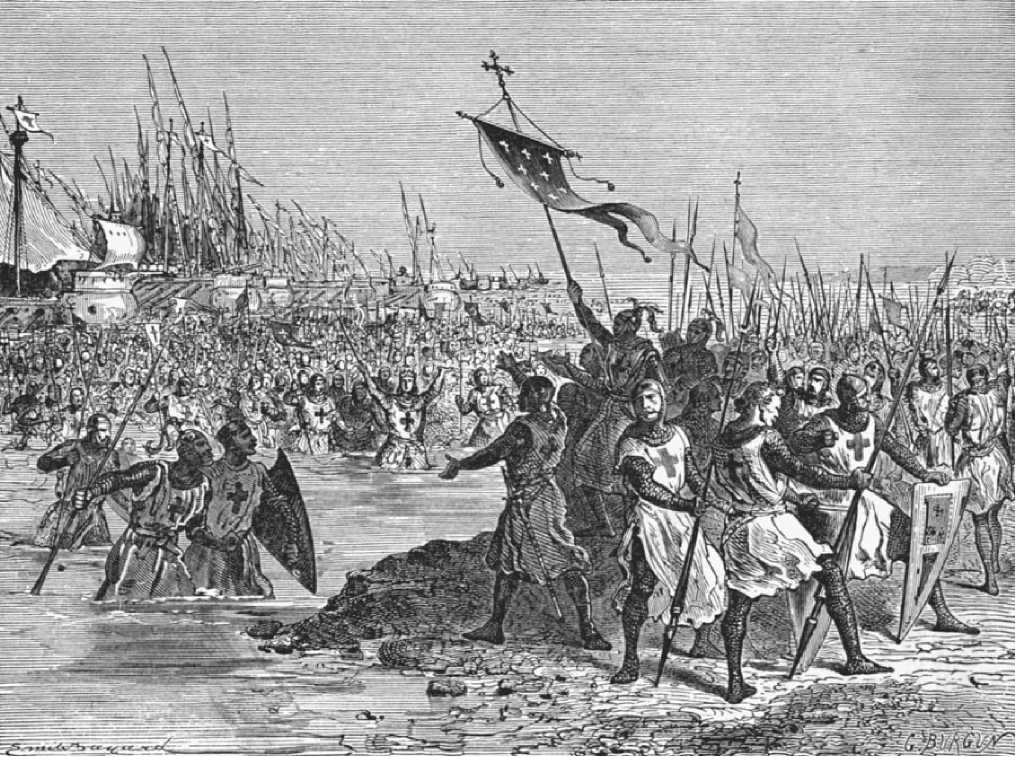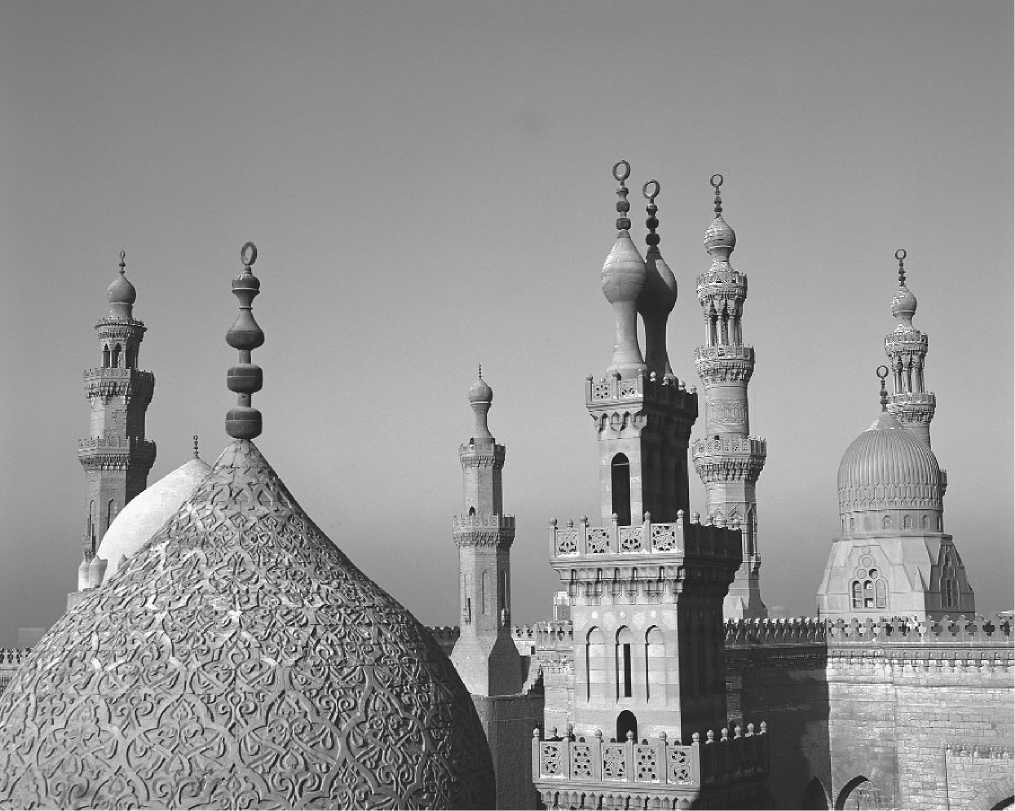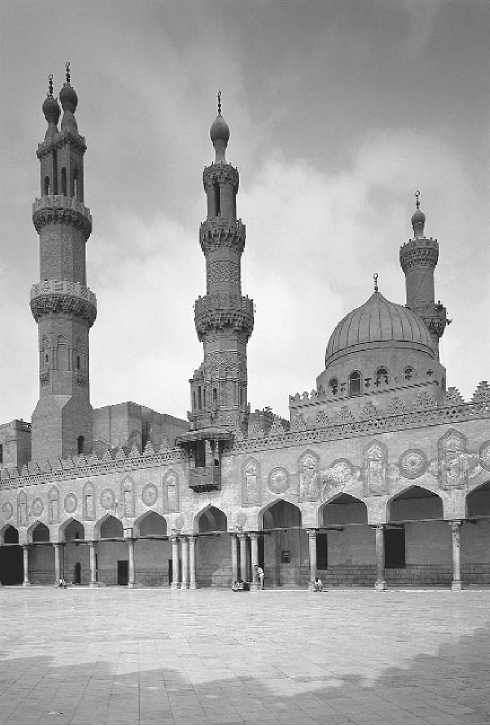At the time of the inception of the crusades, Egypt, under the Fatimid dynasty, was one of the wealthiest and most powerful countries in the Muslim world. The arrival of the First Crusade (1096-1099) and establishment of the kingdom of Jerusalem made the Fatimid possessions in Palestine, and eventually Egypt itself, targets for Frankish expansion, until the Fatimid regime was overthrown by Saladin, who united Egypt with his territories in Muslim Syria. After Saladin’s conquest of Jerusalem and most of Palestine in 1187, Egypt came to figure as the main goal of new crusades from the West, which aimed to secure the liberation of the Holy Land by striking at the center of Muslim power. It was during the final great crusade against Egypt (1248-1254) that Saladin’s Ayyubid successors were overthrown by a caste of Turkish slave soldiers, the Mamluks, who established a powerful sultanate that ultimately extinguished Frankish rule in Outremer in 1291.
Economy, Population, and Society
Medieval Egypt was a unique country that generally enjoyed a great annual agricultural surplus, and served, at least from the late tenth century, as a land bridge for trade between the Mediterranean Sea and the Indian Ocean. The river Nile, along whose banks arable land was concentrated, began its annual rise toward the end of June or the beginning of July, rising moderately each day at irregular rates until the beginning of August; when the rise accelerated until it reached plenitude, approximately 8.32 meters, slightly after 15 August [William Pooper, The Cairo Nilometer (Berkeley: California University Press, 1951)]. The rise of the Nile is recorded in Arabic sources in terms of cubits subdivided into fingers. A level of 16 cubits was regarded as plenitude, signifying a good agricultural year with a plentiful harvest and high tax incomes for the state. A level of 14 cubits was regarded as a disastrous year with high prices, shortages, and starvation. Levels below 14 cubits meant drought, severe starvation accompanied by the outbreak of disease, and high mortality rates. Life and death in medieval Egypt depended on a difference of a meter or two in the annual rise of the life-giving river.
Although demographic assessments are riddled with difficulties, the population of Egypt is generally estimated at 2.6 million for the beginning of the seventh century [Josiah C. Russell, “The Population of Medieval Egypt,” Journal of the American Research Center in Egypt 5 (1966), 69-82]. The Muslim conquest in 641 made little impact on the indigenous Coptic population, and the Coptic Church retained its power and grip over the rural population. The emergence of
A Muslim society in Egypt and the crystallization of Egypt’s Islamic identity were slow and protracted processes. Initially, the Arab population was small and concentrated mainly in Alexandria and in Fustat, the town established by the Arabs adjacent to the Byzantine fortified town of Babylon at the apex of the Nile delta. Fustat developed significantly in terms of population, economic activity, and cultural life during the first 300 years of its existence, serving as the administrative and political center of the country. The first significant Islamization of the rural population took place in the ninth century, following a suppression of rural tax rebellions and a change in Muslim policy toward the Coptic Church. However, Arabization and Islamization were not parallel processes: Arabization advanced faster than Islamization. Copts adhered to their religion but adopted the Arabic language, and, although the same was true of the much smaller Jewish communities, the Jews continued to use Hebrew, giving rise to the Judaeo-Arabic language, Arabic written in Hebrew letters.
The Fatimid Period
Until the emergence of the quasi-independent Tulunid dynasty (868-905), Egypt was ruled as province directly from Damascus and later from Baghdad. The restoration of ‘Abbasid direct rule in Egypt (905-935) was followed by the rise of another semi-independent local dynasty, the Ikhshidids (935-968). The Tulunid and Ikhshidid rulers had much in common. They were Sunni Muslims who strove to carve out for themselves a patrimony in Egypt. They recognized ‘Abbasid sovereignty and made every effort to obtain ‘Abbasid legitimization for their rule. However, the political disintegration of the Ikhshidid regime and the inability of the ‘Abbasids to intervene militarily in Egypt facilitated the conquest of the country in 969 by the Fatimids, a dynasty based in Tunisia. The Fatimids were Isma‘ili Muslims, a Shi‘ite splinter group whose religious and political ambition was the overthrow of the rival Sunni caliphate of the ‘Abbasids at Baghdad. They were able to conquer Palestine and Damascus, but their drive toward Baghdad stopped at Damascus. For Egypt, Fatimid rule brought many changes. The city of Cairo was established as the seat of a dynasty that was to rule over much of the eastern Mediterranean until the late twelfth century, and the presence of the Fatimid regime there stimulated demand for luxury goods, products, and services. Commercial relations with the town of Amalfi (dating back to Fatimid rule in Tunisia), as well as a Fatimid presence in Yemen, were instrumental in the growth of the numbers of Italian and Byzantine merchants in Alexandria and Cairo, setting a pattern for trade between the Mediterranean and the Indian Ocean that lasted up to the sixteenth century. Generally tolerant and liberal, Fatimid policies were conductive to this trade, in which members of the ruling family and upper classes took an active part. The demand created by the regime for textiles, including costly luxury fabrics, gave rise to a textile industry in many parts of the country, including the tirdz (government workshops). Flax, the cultivation of which was introduced by the Tulunids, became one of the main exports.
Many of the economic and urban achievements of the Fatimid period were diminished during the civil war that ravaged the country in 1062-1073, causing much damage to the capital, disrupting agricultural output, and reducing the population (possibly to under 2 million). In 1073, Badr al-Jamali, a Muslim Armenian who was governor of Acre (mod. ‘Akko, Israel) in Palestine, restored order in Egypt, establishing a hereditary military dictatorship of a series of viziers under the nominal rule of the Fatimid caliphs. However, Fatimid rule in Palestine and Syria collapsed in the course of the Saljuq invasion of this region. Nonetheless, Badr repelled the invasion of Egypt by the Saljuq chieftain Atsiz ibn Uwaq (1077) and inaugurated a campaign aiming at the reconquest of Palestine from the Saljuqs, which was continued by his son al-Afdal (vizier 1094-1121). At the time of the First Crusade (1096-1099), southern and central Palestine, including Jerusalem, was held by the Fatimids. However, largely because of internal problems, the Fatimid response to the First Crusade by al-Afdal was hesitant. Fatimid forces were unable to hold Jerusalem, and major invasions of Palestine launched by al-Afdal were defeated by the Franks in 1099, 1101, 1102, and 1105. By 1125 the coast of Palestine had been lost, with only the port of Ascalon (mod. Tel Ashqelon, Israel) remaining as an Egyptian enclave until its capture by the Franks in 1153.
During the rule of Badr al-Jamali and al-Afdal, the immigration of Christian Armenians into Egypt was encouraged, and they were integrated into the large multi-ethnic Fatimid army. Their presence in Egypt (which included the short rule of the Armenian general Bahram as vizier in the mid-1130s) continued until the rise to power of Saladin in 1169.
In 1107 al-Afdal tried to reform the iqtd‘ system (fiscal rights given to emirs over rural areas in exchange of military service). By the twelfth century, regiments of the Fatimid

Crusaders disembark from their ships in Egypt. (Bettmann/Corbis)
Army were paid in cash by the treasury, but the iqta‘ system also spread as a means for paying the army. Emirs who were recipients of iqta‘ tended to be present in areas assigned to them at harvest time in order to secure their fiscal rights, and they also tended to develop local power bases. The rule of Badr al-Jamali and al-Afdal saw a relatively speedy economic and urban restoration of Fustat and Cairo, but the political heritage of Badr al-Jamali’s military rule cast its shadow over the Fatimid polity, bringing the country into the dubious position of the “sick man on the Nile”: economically rich, but politically and militarily weak, and coveted by its more powerful neighbors. Thus, in 1164-1169 the forces of Nur al-Din of Damascus and King Amalric of Jerusalem fought each other on Egyptian soil. The invading Franks were well informed about the agricultural potential of Egypt, having a
List of Egyptian villages and the incomes derived from them. However, Nur al-Din’s forces emerged victorious, and Sal-adin became Fatimid vizier. In the course of these events, large sections of Fustat were burned down, and Saladin’s assault against the Fatimid army in Cairo brought destruction to parts of the town. From 1169 to 1171 Saladin undermined and finally toppled the Fatimid regime, deposing the caliph, al-‘Adid. He ruled the country in the name of Nur al-Din, but on Nur al-Din’s death (1174) Saladin embarked on a war for control of his possessions.
The Ayyubid Period
In 1176, Saladin began to build a citadel on high ground overlooking Cairo, probably as a response to the Frankish invasion and siege of 1169. He also intended to surround

Minarets and domes of the Sultan Hasan and al-Rifa’i mosques, Cairo, Egypt. (Jose Fuste Raga/Corbis)
MmM
Cairo and Fustat with a wall; the encirclement of the capital was left unfinished, but the construction of the citadel was accomplished by his successor Sultan al-Kamil, who moved the court there in 1208. Further expansion of the citadel took place in the second half of the thirteenth century under the Mamluk sultans. Under Saladin the involvement of Egypt in the wars against the Franks intensified greatly, beginning with his disastrous failure at the battle of Montgisard (November 1177) and continuing until his death in 1193. A further problem which first emerged during Saladin’s rule was the defense of the Egyptian coastal towns. Damietta (mod. Dumyat)was attacked by Byzantium and the Franks of Jerusalem in 1169, and Alexandria was attacked by the
Normans of Sicily in 1174. The armies of the Fifth Crusade (1217-1221) conquered Damietta in November 1219, but evacuated Egypt in August 1221. Damietta was captured again in June 1249 by the forces of Louis IX of France, but his crusade ended with the defeat of his army and his own captivity at the battle of Mansurah (February 1250). The greatest impact of the crusades on Egypt was the decline of its Mediterranean coast (with the exception of Alexandria). Economically this was a very important region; the towns of Farama (ancient Pelusium), Tinnis (on Lake Manzala), and Damietta, as well as some villages in the region, were prosperous centers of a textile industry, and the towns also played a role in Mediterranean trade. Tinnis was aban-

Mamluk minarets tower above the Fatimid courtyard at the Al-Azhar Mosque in Cairo, founded in 972. (Angelo Hornak/Corbis)
Doned in 1190 and destroyed in 1227 on the orders of Sultan al-Kamil, but Egypt’s Mediterranean and Indian trade were not affected by such developments, and Italian and Byzantine traders continued to frequent Alexandria as they had done in the eleventh and twelfth centuries.
In contrast to Saladin’s achievements in the holy war against the Franks, his Ayyubid successors adopted an attitude of realpolitik toward them. Their policy of appeasement was a result of military weakness and internal struggles among the members of the Ayyubid dynasty. The Ayyubid armies mustered from Egypt were small, in the range of 8,000-12,000 troops (all cavalry forces), and the iqta‘ became almost the sole means of paying the army. A shortage of gold was a further problem, and consequently the weight of Ayyubid dinars fell below the standard, while the silver content of dirhams varied considerably. To what extent the famine of 1200-1202 had any long-term demographic and agricultural consequences is difficult to assess. It was probably as severe as that of 1024-1025, but such events usually had only short-term effects.
The Mamluk Period
The collapse of Ayyubid rule in Egypt was one of the outcomes of the first Crusade of King Louis IX of France (1248-1254). The sultan al-Salih Najm al-Din died during the fighting, and his son, Turan Shah, failed to win the confidence of the mamluks (slave soldiers) of the Bahriyya corps. This led to their assassination of Turan Shah in 1250, after which Shajar al-Durr, the widow of al-Salih Najm al-Din, ruled for several months in her own name, with the title “Queen of the Muslims.” The political involvement of women behind the scenes was common and widespread, but the public exercise of political power by a woman was a rare occurrence in medieval Islam. In light of the circumstances in which she gained power and the continuing struggle against the crusade of Louis IX, her independent rule had little chance of success. The tumultuous decade of 1250-1260 saw the defeat of Louis IX (1250), the assassination of Shajar al-Durr in 1257, the escape of most of the Bahriyya corps to Ayyubid Damascus, and the rise of the mamluk Qutuz to the sultanate (1259). After the fall of Baghdad to the Mongols in 1258, however, the Mongol threat cast its shadow over Mamluk politics. In March 1260 the Mongols seized Damascus, facilitating a reconciliation between Qutuz and the Bahriyya, led by Baybars. The execution of Mongol emissaries to Cairo put the two powers on a collision course. Qutuz and Baybars led the Mamluk army into Palestine to face the Mongols, thus creating a dilemma for the Franks as to what policy they should adopt; eventually they declared neutrality, allowing free movement to the Mamluk force that, on 3 September 1260, engaged the Mongols at ‘Ayn Jalut in the Jezreel Valley, where they achieved a decisive victory. The reconciliation of Qutuz and Baybars did not last long; on 24 October Qutuz was killed in a plot led by Baybars, who then claimed the throne.
The reign of Baybars I (1260-1277) saw the consolidation of Mamluk power in Egypt and Syria and vigorous campaigns against Mongols and Franks. In the 1265 campaign, the Palestinian coastal towns of Arsuf, Caesarea, and Haifa were captured and razed, and it became policy to destroy the coastal towns in order to prevent any future crusade from obtaining a fortified foothold on the coast. Jaffa (mod. Tel Aviv-Yafo, Israel), taken in 1268, was also demolished, but the inland towns and fortresses of Palestine were rebuilt and populated: these included the town of Saphet (mod. Zefat, Israel), captured in 1266, and the castle of Beaufort, captured in 1268. In Syria Baybars’s greatest achievement was the conquest of Antioch (mod. Antakya, Turkey) in 1268 and several fortresses (1271), including Krak des Chevaliers and Hisn ‘Akkar. The Frankish states posed no direct threat to Egypt, but Baybars’s motives were more complex and wide-ranging. The continued presence of the Franks in the coastal towns offered potential bases for new crusades, and Baybars feared cooperation between the Franks and the Mongols. Finally, territorial gains were important, as they enlarged the power base of the sultan, increasing his ability to reward his confidants and cement new internal political alliances by bestowing land as iqta‘ and freeholdings.
Pressure against the Franks was maintained by the sultans of the Qalawunid family. The founder of the dynasty, Mansur Qalawun (1279-1290), conquered Tripoli (mod. Trablous, Lebanon) in 1289, and his son Ashraf Khalil captured Acre in 1291. Both towns were razed, but Tripoli was rebuilt inland some distance from the sea. The fall of Acre sealed the fate of the other coastal towns of Lebanon—Tyre, Sidon, Beirut, and the fortress of Athlith—bringing the era of Frankish rule to an end. Contrary to what might have been expected, the war waged by the Mamluk sultans on the Franks had no direct consequences for the Copts in Egypt, and the decisive period in the Islamization of Egypt occurred between 1293 and 1354. The Mamluk regime eventually yielded to persistent pressure from the Muslim masses (especially in Cairo) and the clerics, who produced a substantial body of anti-Christian writings. The Mamluk rulers forced conversion on the Copts employed in the administration and allowed the destruction of churches and monasteries. This period saw the reduction of the Copts to a small minority in Egypt.
One of the most crucial events of the Mamluk period was the Black Death of 1347-1348. Its consequences were compounded by the recurrence of plagues, including the fatal pneumonic form, during the fourteenth and fifteenth centuries. Demographic recovery was seriously hindered, and the country remained underpopulated. Demographic decline had long-term consequences on rural output, as well as demand and production in the towns, while mortality among the Mamluk soldiers led to the expensive need to replenish their ranks. Shrinking state revenues caused the Mamluks to adopt harmful economic policies, involving overtaxation and the imposition of trade monopolies. These led to considerable damage to local merchants, including those involved in the Indian trade, and also caused discontent among the Mamluks’ European trading partners. In 1517, the Ottomans conquered an impoverished country that had been badly governed for a long period.
Bibliography
Ashtor, Eliyahu, Levant Trade in the Later Middle Ages (Princeton: Princeton University Press, 1983).
Cambridge History of Egypt, vol. 1: Islamic Egypt, 640-1517, ed. Carl F. Petry (Cambridge: Cambridge University Press, 1998).
Goitein, Shlomo D., A Mediterranean Society (Berkeley: University of California Press, 1967).
Jacoby, David, “Les Italiens en Egypte aux XIIe et XIIe siecles: Du comptoire a la colonie,” in Coloniser au Moyen Age, ed. Michel Balard and A. Ducellier (Paris: Colin, 1995), pp. 76-107.
Lapidus, Ira M., Muslim Cities in the Later Middle Ages (Cambridge: Harvard University Press, 1967).
Lev, Yacov, Saladin in Egypt (Leiden: Brill, 1999).
Little, Donald P., “The Fall of Akka in 690/1291: The Muslim Version,” in Studies in Islamic History and Civilization in Honor of Professor David Ayalon, ed. Moshe Sharon (Jerusalem: Cana, 1986).
Northrup, Linda S., From Slave to Sultan (Stuttgart: Steiner, 1998).
Sato, Tsugitaka, State and Rural Society in Islam (Leiden: Brill, 1997).
Sayyid, Ayman F., La capitale de l’Egypte jusqu’d l’epoque Fatimide (Beirut: Steiner, 1998).
Thorau, Peter, The Lion of Egypt (London: Longman, 1992).
Udovitch, Avrom A., “International Trade and the Medieval Egyptian Countryside,” in Agriculture in Egypt, ed. Alan K. Bowman and Eugene Rogan (Oxford: Oxford University Press, 1999), pp. 267-287.




 World History
World History




![United States Army in WWII - Europe - The Ardennes Battle of the Bulge [Illustrated Edition]](/uploads/posts/2015-05/1432563079_1428528748_0034497d_medium.jpeg)




